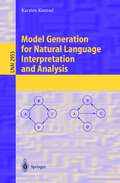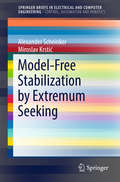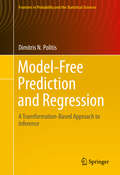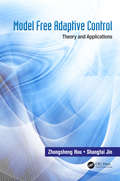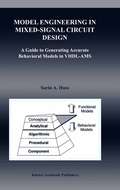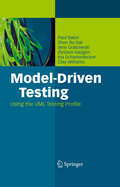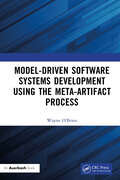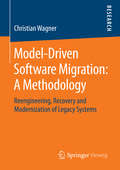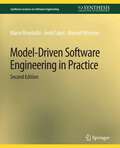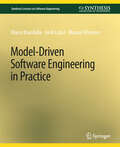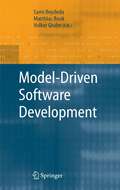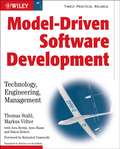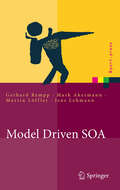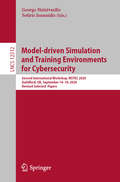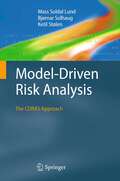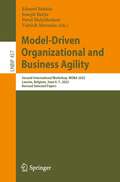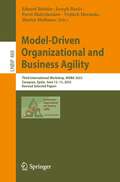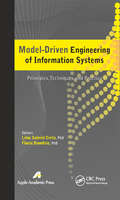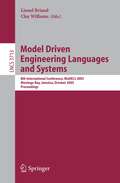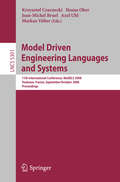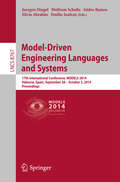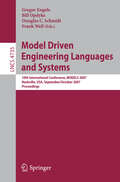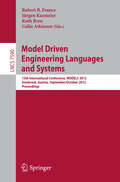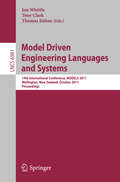- Table View
- List View
Model Generation for Natural Language Interpretation and Analysis (Lecture Notes in Computer Science #2953)
by Karsten KonradMathematical theorem proving has undergone an impressive development during the last two decades, resulting in a variety of powerful systems for applications in mathematical deduction and knowledge processing. Natural language processing has become a topic of outstanding relevance in information technology, mainly due to the explosive growth of the Web, where by far the largest part of information is encoded in natural language documents. This monograph focuses on the development of inference tools tailored to applications in natural language processing by demonstrating how the model generation paradigm can be used as a framework for the support of specific tasks in natural language interpretation and natural language based inference in a natural way. The book appears at a pivotal moment, when much attention is being paid to the task of adding a semantic layer to the Web, and representation and processing of natural language based semantic information pops up as a primary requirement for further technological progress.
Model-Free Stabilization by Extremum Seeking (SpringerBriefs in Electrical and Computer Engineering)
by Alexander Scheinker Miroslav KrstićWith this brief, the authors present algorithms for model-free stabilization of unstable dynamic systems. An extremum-seeking algorithm assigns the role of a cost function to the dynamic system’s control Lyapunov function (clf) aiming at its minimization. The minimization of the clf drives the clf to zero and achieves asymptotic stabilization. This approach does not rely on, or require knowledge of, the system model. Instead, it employs periodic perturbation signals, along with the clf. The same effect is achieved as by using clf-based feedback laws that profit from modeling knowledge, but in a time-average sense. Rather than use integrals of the systems vector field, we employ Lie-bracket-based (i.e., derivative-based) averaging. The brief contains numerous examples and applications, including examples with unknown control directions and experiments with charged particle accelerators. It is intended for theoretical control engineers and mathematicians, and practitioners working in various industrial areas and in robotics.
Model-Free Prediction and Regression: A Transformation-Based Approach to Inference (Frontiers in Probability and the Statistical Sciences)
by Dimitris N. PolitisThe Model-Free Prediction Principle expounded upon in this monograph is based on the simple notion of transforming a complex dataset to one that is easier to work with, e.g., i.i.d. or Gaussian. As such, it restores the emphasis on observable quantities, i.e., current and future data, as opposed to unobservable model parameters and estimates thereof, and yields optimal predictors in diverse settings such as regression and time series. Furthermore, the Model-Free Bootstrap takes us beyond point prediction in order to construct frequentist prediction intervals without resort to unrealistic assumptions such as normality.Prediction has been traditionally approached via a model-based paradigm, i.e., (a) fit a model to the data at hand, and (b) use the fitted model to extrapolate/predict future data. Due to both mathematical and computational constraints, 20th century statistical practice focused mostly on parametric models. Fortunately, with the advent of widely accessible powerful computing in the late 1970s, computer-intensive methods such as the bootstrap and cross-validation freed practitioners from the limitations of parametric models, and paved the way towards the `big data' era of the 21st century. Nonetheless, there is a further step one may take, i.e., going beyond even nonparametric models; this is where the Model-Free Prediction Principle is useful.Interestingly, being able to predict a response variable Y associated with a regressor variable X taking on any possible value seems to inadvertently also achieve the main goal of modeling, i.e., trying to describe how Y depends on X. Hence, as prediction can be treated as a by-product of model-fitting, key estimation problems can be addressed as a by-product of being able to perform prediction. In other words, a practitioner can use Model-Free Prediction ideas in order to additionally obtain point estimates and confidence intervals for relevant parameters leading to an alternative, transformation-based approach to statistical inference.
Model Free Adaptive Control: Theory and Applications
by Zhongsheng Hou Shangtai JinModel Free Adaptive Control: Theory and Applications summarizes theory and applications of model-free adaptive control (MFAC). MFAC is a novel adaptive control method for the unknown discrete-time nonlinear systems with time-varying parameters and time-varying structure, and the design and analysis of MFAC merely depend on the measured input and ou
Model Engineering in Mixed-Signal Circuit Design: A Guide to Generating Accurate Behavioral Models in VHDL-AMS (The Springer International Series in Engineering and Computer Science #649)
by Sorin Alexander HussFor the first time, this up-to-date text combines the main issues of the hardware description language VHDL-AMS aimed at model representation of mixed-signal circuits and systems, characterization methods and tools for the extraction of model parameters, and modelling methodologies for accurate high-level behavioural models.
Model-Driven Testing: Using the UML Testing Profile
by Paul Baker Zhen Ru Dai Jens Grabowski Ina Schieferdecker Clay WilliamsWritten by the original members of an industry standardization group, this book shows you how to use UML to test complex software systems. It is the definitive reference for the only UML-based test specification language, written by the creators of that language. It is supported by an Internet site that provides information on the latest tools and uses of the profile. The authors introduce UTP step-by-step, using a case study that illustrates how UTP can be used for test modeling and test specification.
Model-Driven Software Systems Development Using the Meta-Artifact Process
by Wayne O'BrienThe importance of architecture for software systems is widely accepted, but the role of architecture in the overall development process is not so clear. Presenting an architecture-centric process, Model-Driven Software Systems Development Using the Meta-Artifact Process makes the role of architecture clear. At its core, this book is about developing software systems and, more specifically, software code. It describes three major innovations for making software, which are combined with five widely used enabling technologies, to provide a complete, hypothesis-driven software development process known as Meta-Artifact Process (MAP). Having complete requirements is essential for making good software and supports the hypothesis-driven MAP.MAP offers properties, qualities, and capabilities that help stakeholders and developers understand and reason about a domain and target systems of interest. MAP, through the central role of the Meta-Artifact and incorporating the view that a computer program is a hypothesis about the requirements, offers new ways to look at systems and their development, even changing the roles of developers and stakeholders.Recommending agile methods wherever appropriate while supporting the OMG Essence standard and working within an overarching architecture, MAP presents ways to ensure that the requirements are complete and correct. It helps to identify likely points during development to form alternative hypotheses about them. Because MAP requires an underlying software development process, it can provide that clarity to existing processes in which the organization’s developers are already proficient.This book provides concrete examples from two broad but diverse areas—Accounting Information Systems in the commercial area and a military command and control system—to show the wide applicability of MAP in both commercial and defense domains.
Model-Driven Software Systems Development Using the Meta-Artifact Process
by Wayne O'BrienThe importance of architecture for software systems is widely accepted, but the role of architecture in the overall development process is not so clear. Presenting an architecture-centric process, Model-Driven Software Systems Development Using the Meta-Artifact Process makes the role of architecture clear. At its core, this book is about developing software systems and, more specifically, software code. It describes three major innovations for making software, which are combined with five widely used enabling technologies, to provide a complete, hypothesis-driven software development process known as Meta-Artifact Process (MAP). Having complete requirements is essential for making good software and supports the hypothesis-driven MAP.MAP offers properties, qualities, and capabilities that help stakeholders and developers understand and reason about a domain and target systems of interest. MAP, through the central role of the Meta-Artifact and incorporating the view that a computer program is a hypothesis about the requirements, offers new ways to look at systems and their development, even changing the roles of developers and stakeholders.Recommending agile methods wherever appropriate while supporting the OMG Essence standard and working within an overarching architecture, MAP presents ways to ensure that the requirements are complete and correct. It helps to identify likely points during development to form alternative hypotheses about them. Because MAP requires an underlying software development process, it can provide that clarity to existing processes in which the organization’s developers are already proficient.This book provides concrete examples from two broad but diverse areas—Accounting Information Systems in the commercial area and a military command and control system—to show the wide applicability of MAP in both commercial and defense domains.
Model-Driven Software Migration: Reengineering, Recovery and Modernization of Legacy Systems
by Christian WagnerToday, reliable software systems are the basis of any business or company. The continuous further development of those systems is the central component in software evolution. It requires a huge amount of time- man power- as well as financial resources. The challenges are size, seniority and heterogeneity of those software systems. Christian Wagner addresses software evolution: the inherent problems and uncertainties in the process. He presents a model-driven method which leads to a synchronization between source code and design. As a result the model layer will be the central part in further evolution and source code becomes a by-product. For the first time a model-driven procedure for maintenance and migration of software systems is described. The procedure is composed of a model-driven reengineering and a model-driven migration phase. The application and effectiveness of the procedure are confirmed with a reference implementation applied to four exemplary systems.
Model-Driven Software Engineering in Practice, Second Edition (Synthesis Lectures on Software Engineering)
by Marco Brambilla Jordi Cabot Manuel WimmerThis book discusses how model-based approaches can improve the daily practice of software professionals. This is known as Model-Driven Software Engineering (MDSE) or, simply, Model-Driven Engineering (MDE). MDSE practices have proved to increase efficiency and effectiveness in software development, as demonstrated by various quantitative and qualitative studies. MDSE adoption in the software industry is foreseen to grow exponentially in the near future, e.g., due to the convergence of software development and business analysis. The aim of this book is to provide you with an agile and flexible tool to introduce you to the MDSE world, thus allowing you to quickly understand its basic principles and techniques and to choose the right set of MDSE instruments for your needs so that you can start to benefit from MDSE right away. The book is organized into two main parts. The first part discusses the foundations of MDSE in terms of basic concepts (i.e., models and transformations), driving principles, application scenarios, and current standards, like the well-known MDA initiative proposed by OMG (Object Management Group) as well as the practices on how to integrate MDSE in existing development processes. The second part deals with the technical aspects of MDSE, spanning from the basics on when and how to build a domain-specific modeling language, to the description of Model-to-Text and Model-to-Model transformations, and the tools that support the management of MDSE projects. The second edition of the book features: a set of completely new topics, including: full example of the creation of a new modeling language (IFML), discussion of modeling issues and approaches in specific domains, like business process modeling, user interaction modeling, and enterprise architecture complete revision of examples, figures, and text, for improving readability, understandability, and coherence better formulation of definitions, dependencies between concepts and ideas addition of a complete index of book content In addition to the contents of the book, more resources are provided on the book's website http://www.mdse-book.com, including the examples presented in the book.
Model-Driven Software Engineering in Practice (Synthesis Lectures on Software Engineering)
by Marco Brambilla Jordi Cabot Manuel WimmerThis book discusses how model-based approaches can improve the daily practice of software professionals. This is known as Model-Driven Software Engineering (MDSE) or, simply, Model-Driven Engineering (MDE). MDSE practices have proved to increase efficiency and effectiveness in software development, as demonstrated by various quantitative and qualitative studies. MDSE adoption in the software industry is foreseen to grow exponentially in the near future, e.g., due to the convergence of software development and business analysis. The aim of this book is to provide you with an agile and flexible tool to introduce you to the MDSE world, thus allowing you to quickly understand its basic principles and techniques and to choose the right set of MDSE instruments for your needs so that you can start to benefit from MDSE right away. The book is organized into two main parts. The first part discusses the foundations of MDSE in terms of basic concepts (i.e., models and transformations), driving principles, application scenarios and current standards, like the well-known MDA initiative proposed by OMG (Object Management Group) as well as the practices on how to integrate MDSE in existing development processes. The second part deals with the technical aspects of MDSE, spanning from the basics on when and how to build a domain-specific modeling language, to the description of Model-to-Text and Model-to-Model transformations, and the tools that support the management of MDSE projects. The book is targeted to a diverse set of readers, spanning: professionals, CTOs, CIOs, and team managers that need to have a bird's eye vision on the matter, so as to take the appropriate decisions when it comes to choosing the best development techniques for their company or team; software analysts, developers, or designers that expect to use MDSE for improving everyday work productivity, either by applying the basic modeling techniques and notations or by defining new domain-specific modeling languages and applying end-to-end MDSE practices in the software factory; and academic teachers and students to address undergrad and postgrad courses on MDSE. In addition to the contents of the book, more resources are provided on the book's website, including the examples presented in the book. Table of Contents: Introduction / MDSE Principles / MDSE Use Cases / Model-Driven Architecture (MDA) / Integration of MDSE in your Development Process / Modeling Languages at a Glance / Developing your Own Modeling Language / Model-to-Model Transformations / Model-to-Text Transformations / Managing Models / Summary
Model-Driven Software Development
by Sami Beydeda Matthias Book Volker GruhnAbstraction is the most basic principle of software engineering. Abstractions are provided by models. Modeling and model transformation constitute the core of model-driven development. Models can be refined and finally be transformed into a technical implementation, i.e., a software system. The aim of this book is to give an overview of the state of the art in model-driven software development. Achievements are considered from a conceptual point of view in the first part, while the second part describes technical advances and infrastructures. Finally, the third part summarizes experiences gained in actual projects employing model-driven development. Beydeda, Book and Gruhn put together the results from leading researchers in this area, both from industry and academia. The result is a collection of papers which gives both researchers and graduate students a comprehensive overview of current research issues and industrial forefront practice, as promoted by OMG’s MDA initiative.
Model-Driven Software Development: Technology, Engineering, Management (Wiley Software Patterns Series)
by Markus Völter Thomas Stahl Jorn Bettin Arno Haase Simon HelsenModel-Driven Software Development (MDSD) is currently a highly regarded development paradigm among developers and researchers. With the advent of OMG's MDA and Microsoft's Software Factories, the MDSD approach has moved to the centre of the programmer's attention, becoming the focus of conferences such as OOPSLA, JAOO and OOP. MDSD is about using domain-specific languages to create models that express application structure or behaviour in an efficient and domain-specific way. These models are subsequently transformed into executable code by a sequence of model transformations. This practical guide for software architects and developers is peppered with practical examples and extensive case studies. International experts deliver: * A comprehensive overview of MDSD and how it relates to industry standards such as MDA and Software Factories. * Technical details on meta modeling, DSL construction, model-to-model and model-to-code transformations, and software architecture. * Invaluable insight into the software development process, plus engineering issues such as versioning, testing and product line engineering. * Essential management knowledge covering economic and organizational topics, from a global perspective. Get started and benefit from some practical support along the way!
Model Driven SOA: Anwendungsorientierte Methodik und Vorgehen in der Praxis (Xpert.press)
by Gerhard Rempp Mark Akermann Martin Löffler Jens LehmannServiceorientierte Architektur (SOA) hat sich durchgesetzt, wer sie beherrscht, hat einen Wettbewerbsvorteil. Deshalb stellt sich meist nicht die Frage, ob SOA angewendet werden soll, sondern wie sie umgesetzt werden kann. Die Autoren geben anhand eines Anwendungsbeispiels einen Überblick über die modellgetriebene Softwareentwicklung. Sie zeigen, wie sich mit Modellierungsnotationen und mit Generatoren die werkzeuggestützte Entwicklung von SOA-Anwendungen effizient und dauerhaft umsetzen lässt. Mit allen notwendigen Sourcecodes und Dokumentationen.
Model-driven Simulation and Training Environments for Cybersecurity: Second International Workshop, MSTEC 2020, Guildford, UK, September 14–18, 2020, Revised Selected Papers (Lecture Notes in Computer Science #12512)
by George Hatzivasilis Sotiris IoannidisThis book constitutes the refereed post-conference proceedings of the Second International Workshop on Model-Driven Simulation and Training Environments for Cybersecurity, MSTEC 2020, held in Guildford, UK, in September 2020 in conjunction with the 24th European Symposium on Research in Computer Security, ESORICS 2020. The conference was held virtually due to the COVID-19 pandemic. The MSTEC Workshop received 20 submissions from which 10 full papers were selected for presentation. The papers are grouped in thematically on: cyber security training modelling; serious games; emulation & simulation studies; attacks; security policies.
Model-Driven Risk Analysis: The CORAS Approach
by Mass Soldal Lund Bjørnar Solhaug Ketil StølenThe term “risk” is known from many fields, and we are used to references to contractual risk, economic risk, operational risk, legal risk, security risk, and so forth. We conduct risk analysis, using either offensive or defensive approaches to identify and assess risk. Offensive approaches are concerned with balancing potential gain against risk of investment loss, while defensive approaches are concerned with protecting assets that already exist. In this book, Lund, Solhaug and Stølen focus on defensive risk analysis, and more explicitly on a particular approach called CORAS. CORAS is a model-driven method for defensive risk analysis featuring a tool-supported modelling language specially designed to model risks. Their book serves as an introduction to risk analysis in general, including the central concepts and notions in risk analysis and their relations. The authors’ aim is to support risk analysts in conducting structured and stepwise risk analysis. To this end, the book is divided into three main parts. Part I of the book introduces and demonstrates the central concepts and notation used in CORAS, and is largely example-driven. Part II gives a thorough description of the CORAS method and modelling language. After having completed this part of the book, the reader should know enough to use the method in practice. Finally, Part III addresses issues that require special attention and treatment, but still are often encountered in real-life risk analysis and for which CORAS offers helpful advice and assistance. This part also includes a short presentation of the CORAS tool support. The main target groups of the book are IT practitioners and students at graduate or undergraduate level. They will appreciate a concise introduction into the emerging field of risk analysis, supported by a sound methodology, and completed with numerous examples and detailed guidelines.
Model-Driven Organizational and Business Agility: Second International Workshop, MOBA 2022, Leuven, Belgium, June 6–7, 2022, Revised Selected Papers (Lecture Notes in Business Information Processing #457)
by Eduard Babkin Joseph Barjis Pavel Malyzhenkov Vojtěch MerunkaThis book constitutes the proceedings of the Second International Workshop on Model-Driven Organizational and Business Agility, MOBA 2022, which took place in Leuven, Belgium, in June 2022.MOBA was launched with the purpose of fetching scientific rigor into the agile practice within an entire enterprise, especially focusing on the role of models and modeling. The 10 papers presented in this volume were carefully reviewed and selected from 22 submissions. They cover topics like business intelligence, agile business rules, agile software development, adaptive domain-specific interfaces, or reconfigurable software architectures.
Model-Driven Organizational and Business Agility: Third International Workshop, MOBA 2023, Zaragoza, Spain, June 12–13, 2023, Revised Selected Papers (Lecture Notes in Business Information Processing #488)
by Eduard Babkin Joseph Barjis Pavel Malyzhenkov Vojtěch Merunka Martin MolhanecThis book constitutes the proceedings of the Third International Workshop on Model-Driven Organizational and Business Agility, MOBA 2023, which took place in Zaragoza, Spain, in June 2023. MOBA was launched with the purpose of fetching scientific rigor into the agile practice within an entire enterprise, especially focusing on the role of models and modeling. The 9 papers presented in this volume were carefully reviewed and selected from 18 submissions. They cover topics like business intelligence, agile business rules, agile software development, adaptive domain-specific interfaces, or reconfigurable software architectures.
Model-Driven Engineering of Information Systems: Principles, Techniques, and Practice
by Liviu Gabriel Cretu Florin DumitriuThis title includes a number of Open Access chapters.Model-driven engineering (MDE) is the automatic production of software from simplified models of structure and functionality. It mainly involves the automation of the routine and technologically complex programming tasks, thus allowing developers to focus on the true value-adding functionality th
Model Driven Engineering Languages and Systems: 8th International Conference, MoDELS 2005, Montego Bay, Jamaica, October 2-7, 2005, Proceedings (Lecture Notes in Computer Science #3713)
by Lionel Briand Clay WilliamsModel Driven Engineering Languages and Systems: 11th International Conference, MoDELS 2008, Toulouse, France, September 28 - October 3, 2008, Proceedings (Lecture Notes in Computer Science #5301)
by Krzysztof Czarnecki Ileana Ober Jean-Michel Bruel Axel Uhl Markus VölterThis book constitutes the refereed proceedings of the 11th International Conference on Model Driven Engineering Languages and Systems, MoDELS 2008, held in Toulouse, France, during September 28-October 3, 2008. The 58 revised full papers presented were carefully reviewed and selected from 271 submissions. The book also contains three keynote speeches and contributions to workshops, symposia, tutorials and panels at the conference. The papers are organized in topical sections on Model Transformation: Foundations; Requirements Modeling; Domain-Specific Modeling; Model Transformation: Techniques, Composition and Analysis of Behavioral Models; Model Comprehension; Model Management; Behavioral Conformance and Refinement; Metamodeling and Modularity; Constraints; Model Analysis; Service-Oriented Architectures; Adaptive and Autonomic Systems; Empirical Studies; Evolution and Reverse Engineering; Modeling Language Semantics; Dependability Analysis and Testing; Aspect-Oriented Modeling; Structural Modeling;and Embedded Systems.
Model-Driven Engineering Languages and Systems: 17th International Conference, MODELS 2014, Valencia, Spain, September 283– October 4, 2014. Proceedings (Lecture Notes in Computer Science #8767)
by Juergen Dingel Wolfram Schulte Isidro Ramos Silvia Abrahao Emilio InsfranThis book constitutes the refereed proceedings of the 17th International Conference on Model Driven Engineering Languages and Systems, MODELS 2014, held in Valencia, Spain, in September/October 2014. The 41 full papers presented in this volume were carefully reviewed and selected from a total of 126 submissions. The scope of the conference series is broad, encompassing modeling languages, methods, tools, and applications considered from theoretical and practical angles and in academic and industrial settings. The papers report on the use of modeling in a wide range of cloud, mobile, and web computing, model transformation behavioral modeling, MDE: past, present, future, formal semantics, specification, and verification, models at runtime, feature and variability modeling, composition and adaptation, practices and experience, modeling for analysis, pragmatics, model extraction, manipulation and persistence, querying, and reasoning.
Model Driven Engineering Languages and Systems: 10th International Conference, MoDELS 2007, Nashville, USA, September 30 - October 5, 2007, Proceedings (Lecture Notes in Computer Science #4735)
by Gregor Engels Bill Opdyke Douglas C. Schmidt Frank WeilThis book constitutes the refereed proceedings of the 10th International Conference on Model Driven Engineering Languages and Systems (formerly the UML series of conferences), MODELS 2007, held in Nashville, USA, September 30 - October 5, 2007. The 45 revised full papers were carefully reviewed and selected from 158 initial submissions. The papers are organized in topical sections.
Model Driven Engineering Languages and Systems: 15th International Conference, MODELS 2012, Innsbruck, Austria, September 30 -- October 5, 2012, Proceedings (Lecture Notes in Computer Science #7590)
by Robert B. France Jürgen Kazmeier Ruth Breu Colin AtkinsonThis book constitutes the refereed proceedings of the 15th International Conference on Model Driven Engineering Languages and Systems, MODELS 2012, held in Innsbruck, Austria, in September/October 2012. The 50 papers presented in this volume were carefully reviewed and selected from a total of 181 submissions. They are organized in topical sections named: metamodels and domain specific modeling; models at runtime; model management; modeling methods and tools, consistency analysis, software product lines; foundations of modeling; static analysis techniques; model testing and simulation; model transformation; model matching, tracing and synchronization; modeling practices and experience; and model analysis.
Model Driven Engineering Languages and Systems: 14th International Conference, MODELS 2011, Wellington, New Zealand, October 16-21, 2011, Proceedings (Lecture Notes in Computer Science #6981)
by Thomas Kühne Jon Whittle Tony ClarkThis book constitutes the refereed proceedings of the 14th International Conference on Model Driven Engineering Languages and Systems, MODELS 2011, held in Wellington, New Zealand, in October 2011. The papers address a wide range of topics in research (foundations track) and practice (applications track). For the first time a new category of research papers, vision papers, are included presenting "outside the box" thinking. The foundations track received 167 full paper submissions, of which 34 were selected for presentation. Out of these, 3 papers were vision papers. The application track received 27 submissions, of which 13 papers were selected for presentation. The papers are organized in topical sections on model transformation, model complexity, aspect oriented modeling, analysis and comprehension of models, domain specific modeling, models for embedded systems, model synchronization, model based resource management, analysis of class diagrams, verification and validation, refactoring models, modeling visions, logics and modeling, development methods, and model integration and collaboration.
